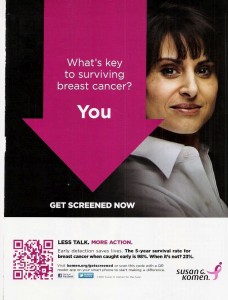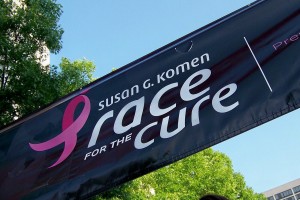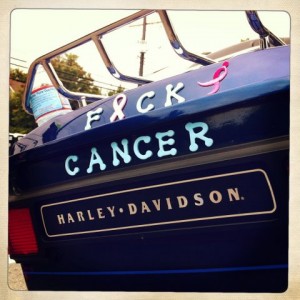Back in February, a scandal broke out at Susan G. Komen for the Cure®, the breast cancer advocacy group with the trademarked pink ribbon. That scandal centered around the group’s decision to stop funding Planned Parenthood’s cancer screening efforts. But the flap over Planned Parenthood obscured an even more scandalous problem at Komen — the group’s outright denialism of tumor biology.
I wrote about the problem here on February 8. On August 2, Dartmouth researchers Steven Woloshin and Lisa M Schwartz published an editorial echoing the points in my post. Komen’s response? Silence.
Schwartz tells me, “We never heard from Komen.” If leaders at the group read the Dartmouth paper, they didn’t seem to draw many lessons. According to Schwartz, the group’s new website, I Am the Cure, contains no survival statistics.
“They now seem to be highlighting breast cancer in young people (1 of their 5 quiz questions is about how women in 20’s can get breast cancer),” Schwartz says, “And one of their big ads is about a college senior with metastatic cancer.” There’s nothing wrong with giving a voice to young women facing breast cancer, but it’s deceptive to imply that these stories are typical. The median age at diagnosis is 61.
The deceptive ad that I criticized in February continues to be featured on the Komen website. With National Breast Cancer Awareness Month once again upon us, it seems like a good time to revisit the issue. What follows is my original post from February.
-Christie
Is breast cancer threatening your life? This Susan G. Komen for the Cure® ad leaves no doubt about who’s to blame —you are. Over the last week or so, critics have found many reasons to fault Susan G. Komen for the Cure®. The scrutiny began with the revelation that the group was halting its grants to Planned Parenthood. The decision seemed like a punitive act that would harm low-income women (the money had funded health services like clinical breast exams), and Komen’s public entry into the culture wars came as a shock to supporters who’d viewed the group as nonpartisan.*
Chatter on the intertubes quickly blamed the move on Komen’s new Vice-President of Public Policy, Karen Handel, a failed GOP candidate who ran for governor in Georgia on a platform that called for defunding Planned Parenthood.** Komen’s founder, Ambassador Nancy Brinker, awkwardly attempted to explain the decision, and yesterday, Handel resigned her position. (Whether she’ll receive a golden parachute remains unclear, but former CEO Hala Moddelmog received $277,864 in 2010, despite her resignation at the end of 2009.) The Planned Parenthood debacle brought renewed attention to other controversies that have hounded Komen in recent years—like its “lawsuits for the cure” program that spent nearly $1 million suing groups like “cupcakes for the cure” and “kites for the cure” over their daring attempts to use the now-trademarked phrase “for the cure.” Critics also pointed to Komen’s relentless marketing of pink ribbon-themed products, including a Komen-branded perfume alleged to contain carcinogens, and pink buckets of fried chicken, a campaign that led one rival breast cancer advocacy group to ask, “what the cluck?” 
But these problems are minuscule compared to Komen’s biggest failing—its near outright denial of tumor biology. The pink arrow ads they ran in magazines a few months back provide a prime example. “What’s key to surviving breast cancer? YOU. Get screened now,” the ad says. The unmistakeable takeaway? It’s your fault if you die of cancer. The blurb below the big arrow explains why. “Early detection saves lives. The 5-year survival rate for breast cancer when caught early is 98%. When it’s not? 23%.
If only it were that simple. As I’ve written previously here, the notion that breast cancer is a uniformly progressive disease that starts small and only grows and spreads if you don’t stop it in time is flat out wrong. I call it breast cancer’s false narrative, and it’s a fairy tale that Komen has relentlessly perpetuated.
It was a mistake that most everyone made in the early days. When mammography was new and breast cancer had not yet become a discussion for the dinner table, it really did seem like all it would take to stop breast cancer was awareness and vigilant screening. The thing about the false narrative is that it makes intuitive sense–a tumor starts as one rogue cell that grows out of control, eventually becoming a palpable tumor that gets bigger and bigger until it escapes its local environment and becomes metastatic, the deadly trait that’s necessary to kill you. And this story has a grain of truth to it—it’s just that it’s far more complicated than that.
Years of research have led scientists to discover that breast tumors are not all alike. Some are fast moving and aggressive, others are never fated to metastasize. The problem is that right now we don’t have a surefire way to predict in advance whether a cancer will spread or how aggressive it might become. (Scientists are working on the problem though.)
Some breast cancers will never become invasive and don’t need treatment. These are the ones most apt to be found on a screening mammogram, and they’re the ones that make people such devoted advocates of mammography. H. Gilbert Welch of the Dartmouth Institute for Health Policy and Clinical Practice, calls this the overdiagnosis paradox. Overdiagnosis is what happens when a mammogram finds an indolent cancer. A healthy person whose life was never threatened by breast cancer is suddenly turned into a cancer survivor. She thinks the mammogram saved her life, and so she becomes an advocate of the test.
Some cancers behave just the opposite of these slow-growing, indolent ones. Researchers now know that some cancers are extremely aggressive from the start. There’s simply no such thing as “early” detection for these cancers. By the time they’re detectable by any of our existing methods, they’ve already metastasized. These are the really awful, most deadly cancers, and screening mammograms*** will not stop them.
Then there are cancers that fall somewhere in between the two extremes. These are the ones most likely to be helped by screening mammography, and they’re the lives that mammography saves. How many? For women age 50 to 70, routine screening mammography decreases mortality by 15 to 20% (numbers are lower for younger women). One thousand women in their 50’s have to be screened for 10 years for a single life to be saved. 
So let’s recap. Getting “screened now,” as the Komen ad instructs can lead to three possible outcomes. One, it finds a cancer than never needed finding. You go from being a healthy person to a cancer survivor, and if you got the mammogram because of Komen’s prodding, you probably become a Komen supporter. Perhaps a staunch one, because hey—they saved your life and now you have a happy story to share with other supporters.
Another possibility is that the mammogram finds a cancer that’s the really bad kind, but you die anyway. You probably don’t die later than you would have without the mammogram, but it might look that way because of a problem called “lead time bias.”
The third possibility is that you find a cancer that’s amenable to treatment and instead of dying like you would without treatment, your life is saved. Here again, you’re grateful to Komen, and in this case, your life truly was saved.
Right now, breast cancer screening sucks. It’s not very effective, and if you measure it solely based on the number of lives saved versus healthy people unnecessarily subjected to cancer treatments, it seems to cause more harm than good. For every life saved, about 10 more lives are unnecessarily turned upside down by a cancer diagnosis that will only harm them. In a study published online in November, Danish researchers concluded that, “Avoiding getting screening mammograms reduces the risk of becoming a breast cancer patient by one-third.”
But it’s not quite that simple. Some people really are helped by mammography screening, and if you’re the one helped, it’s hard to discount that one life. Right now mammography is the best tool we have. Welch, who has spent more time than probably anyone else in America studying this issue, has deemed the decision about whether or not to get breast cancer screening a “close call.”
Reasonable women can decide that for them, the potential benefits outweigh the risks. Other reasonable women will decide that for them, the risks outweigh the potential benefits.
Komen isn’t wrong to encourage women to consider mammography. But they’re dead wrong to imply that “the key to surviving breast cancer” is “you” and the difference between a 98% survival rate and a 23% one is vigilance on the part of the victim. This message flies in the face of basic cancer biology.
Between 2004 to 2009, Komen allocated 47% of it $1.54 billion toward education and screening. Much of its education messaging promotes the same false narrative as its ads, which means they are not only not furthering the search for a cure, they are harming the cause. By implying that the solution to breast cancer is screening, Komen distracts attention from the real problem, which is that way too many women (and men) are still dying of breast cancer, and screening is not saving them. We still can’t prevent breast cancer, because we don’t know what causes it.
To explain why Komen’s fixation on an unscientific story matters, I want to introduce you to Rachel Cheetham Moro. Moro was a cancer blogger, but she won’t be weighing in on this latest Komen controversy, because she died Monday of metastatic breast cancer. Before she left us, she had plenty to say about the false narrative Komen was peddling. Last October she wrote,  How dare Komen so FALSELY suggest that a screening mammogram is all it takes to avoid metastatic breast cancer? How dare Komen so CRUELLY suggest that “not getting screened for breast cancer in time” would be THE reason and the FAULT of the person with metastatic disease who misses out on all the experiences and joyous events of a long and healthy life that so many others take for granted? How dare you, Komen? How dare you?
How dare Komen so FALSELY suggest that a screening mammogram is all it takes to avoid metastatic breast cancer? How dare Komen so CRUELLY suggest that “not getting screened for breast cancer in time” would be THE reason and the FAULT of the person with metastatic disease who misses out on all the experiences and joyous events of a long and healthy life that so many others take for granted? How dare you, Komen? How dare you?
In August of 2009, I wrote about the overdiagnosis problem for the Los Angeles Times. I happened to be attending a conference with several executives from Komen. When I asked them about overdiagnosis, they were dumbfounded. They had no idea what I was talking about. Nor did they seem very interested. (Interestingly enough, two of these women were breast cancer survivors, and told me they’d found their cancers on their own–in the shower or the like–without a self-exam or mammogram.) VP of health sciences Elizabeth Thompson told me that they just needed to keep plugging their message— “early detection saves lives.”
By contrast, Komen’s chief scientific advisor, Eric Winer of the Dana-Farber Cancer Institute, was fully aware of the problem. He told me that “As painful as it is to admit, we have oversold mammography to the American public.” That was more than two years ago. Why is Komen clinging to their denialist message? They owe Moro an answer.
Footnotes:
*In fact, Komen has a long and cozy association with the Republican Party. George W. Bush rewarded founder Nancy Brinker’s generous donations to the GOP—more than $175,000 since 1990—by awarding her an ambassadorship to Hungary in 2001 and later, the position of chief protocol officer. The Komen board has a couple women of color and several democrats, but is predominately rich, white GOP donors.
**Apparently, some abortion foes think that eliminating Planned Parenthood would also abolish abortion. Will Saletan at Slate debunks this notion by explaining that the way to drive Planned Parenthood out of the abortion business is to give them more money.
***It’s important to distinguish a screening mammogram from a diagnostic one. Screening mammograms are done on women without any symptoms. A diagnostic mammogram is done to check out a suspicious lump. Disagreements over mammograms center over whether and how often women should have screening mammograms. Diagnostic mammograms are not in dispute. If you find a lump, you need a diagnostic mammogram.
For more on this issue, read Barbara Ehrenreich’s 2001 famous Harper’s piece, Welcome to Cancerland.
Photos: Race for the Cure banner by Ladybugbkt (via Flickr) Fnck cancer by Michaelhyman300 (via Flickr)

Thanks for this, Christie. I wrote a brief history of pinkwashing and Breast Cancer Action for my KQED QUEST blog that will appear tomorrow. Almost didn’t do it because it’s been said so many times before, but as we both know, it takes a long time to kill a false narrative.
Thanks to both of you. I don’t think you can say this too much.
Liza, will you post a link here when your piece is published? Looking forward to reading it.
I have written about the over-diagnosis issues more than once on my own blog, but your piece is excellent. I have never been a Komen fan, but your insights actually transform my gut feelings into real persuasive arguments as to why their approach is so wrong. Thank you for this!
It’s not that screening is necessarily wrong, its that its not very good and it only a part of the solution. Turning the Komen philosophy around, do they really want to be seen to abandon women (and men) who are diagnosed? Instead of blindly pushing the poor performance of conventional mammography, they need to be lighting the path towards better understanding. But they are also married to “the cure” which is a blinding approach that massively over-promises and under-delivers to every woman who develops breast cancer. At some point, the public is going to demand to know why these promises are not being kept and will lose confidence and trust in research in general. We need to be more transparent and not act as though we are trying to sell cars. The reason we need to do research is because we are still largely clueless when it comes to cancer fundamentals, despite considerable progress.
The ironic thing is that the late Susan Komen HERSELF is a poster child for how the message being peddled in her name is false. She was diagnosed with aggressive breast cancer at 33 and died of it three years later. Would earlier detection of her tumor have helped her – or saved her life? There is no way to completely know, as there have been many advances in treatment since Komen’s death in 1980. But generally speaking, women who are diagnosed with metastatic cancer in their thirties have the super-aggressive, super-untreatable varieties – specifically the kind that tend to have poor long-term prognoses and treatment options.
Great point Esteleth. This makes it all the more puzzling that the Komen foundation hasn’t devoted more focus to metastatic breast cancer and the needs of those patients.
I think this TED talk shows why this article highlights an important issue. We can do more to make breast cancer screening better, but it needs a more considered view of how and when mammograms are effective:
http://www.ted.com/talks/deborah_rhodes.html
Yes it adds some complexity to the message, but the more we learn the more we find that each of us has our own set of risks and resistances to various diseases/conditions. Rather than saying such complexity is too difficult we should be working on ways to communicate that information to people.